Nathan Rapoport
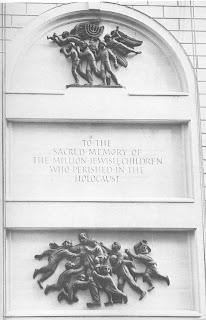
I'd never heard of Nathan Rapoport until last week,
but I first saw his sculpture about 25 years ago,
since the Park Avenue Synagogue is located between my grandmother's apartment
on 88th at Lexington
-- and the Metropolitan Museum on Fifth Ave at 82nd.
This facade dedicated to Janusz Korczak, ''The King of Children'', was
something of an anomaly when it was made in 1980,
since figure sculpture had been banished from architecture for
at least 30 years by that time
(and it had been banished from Jewish temples forever)
 It had design -- it had drama,
It had design -- it had drama,it had a kind of sweet dreaminess.
It was doing its job.
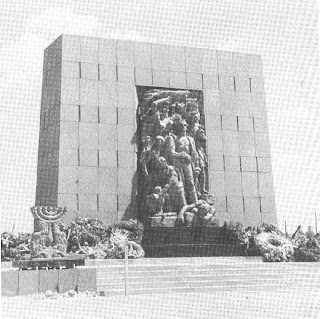 And now I've learned that the sculptor's career
And now I've learned that the sculptor's careergoes back to this piece dedicated in 1948
to the fighters of the Warsaw Ghetto uprising.
I can't find a bio for Rapoport on the web -- so all I've got is an the introductory essay written by a journalist, Richard Yaffe. We're told about his grandfathers (both Chassidim - a cantor and butcher) but what about his parents ? We're told he went to the Warsaw Academy of Art -- but how long was he there ? He was 28 when Poland was invaded, and the story is told that he set out on foot to find and join the Polish army, but for some curious reason, he took a portofolio of his work with him -- which he showed to Soviet authorities, some of whom, from the Minsk Art Commission, invited him to Minsk -- where he must have joined the Artist's Union because
he worked on a monument to Stalin (who else ?) with Abram Brazer (1892-1942)
There, he attracted the attention of a miltary official, Kulagin (first name ?), who protected and patronized him throughout the war years. His first great monument was this tribute to the Warsaw Ghetto - begun in 1943, and eventually erected after the war in 1945
using "splendid Labrador granite, ordered cut originally by Arno Breker, for a monument to commemorate Hitler's victory"
Then he went to Israel, beginning with a monument to a Anilewicz, a hero of the Warsaw Ghetto - to commemorate a Kibbutz destroyed in the Egyptian war, Yad Mordechai. He went on to make other monuments in Isreal as well as Philadelphia, New York, and Toronto.
But whatever happened to his career as a Soviet sculptor ? Did he defect ? Did he become an Israeli citizen ? And whatever happened to General Kulagin ? I wish someone in his family would put up a website to answer all these questions !

Here's some details from the Warsaw monument
(which, incidentally, was reproduced in Yad Vashem, Israel)
 There's that same kind of passionate idealism I found here in the 19the C. Jewish sculptor from Baltimore (whom I'm sure Rapoport had never seen), and that sorrowful intensity of the early 20th C. sculptor Glicenstein as well.
There's that same kind of passionate idealism I found here in the 19the C. Jewish sculptor from Baltimore (whom I'm sure Rapoport had never seen), and that sorrowful intensity of the early 20th C. sculptor Glicenstein as well.It's not cool Classical -- it's not detached.
But it also feels -- well -- small and broken
 a little like the puffery of a cartoon character
a little like the puffery of a cartoon character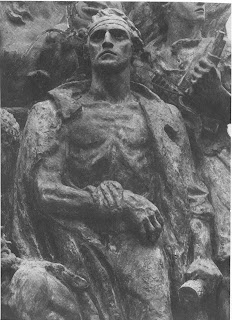 But it does have its moments -
But it does have its moments -like this doomed hero -- and how it compares
with Arno Breker's doomed Nazi hero shown here

This is the monument to Anilewicz, another one of Rapoport's doomed heroes.
And isn't that best kind ?
( failure being proof of the challenge undertaken)

I look at this -- and hear the theme song from "Exodus"
swelling up in the background.
I guess you could call this "movie sculpture"
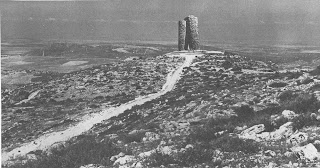 This is quite a monument, isn't it ?
This is quite a monument, isn't it ?It's really become part of a landscape
 My friend from Iowa recognizes these as silos
My friend from Iowa recognizes these as silos(but even a half-jew like myself can see that they're giant torah scrolls!)
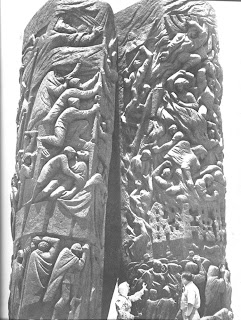 Look at the size of these things!
Look at the size of these things!They're not boring -- but I'm not sure they will have the after-life
that ancient Assyrian reliefs, for example, have in art museums.
(in contrast to these dramatic reliefs by another 20th C. sculptor, Emilio Greco.)


Or compare the above version of Job -- to this one by Milton Horn.
For me the comparison is hardly fair -- since I've only seen the Horn in person --
but via photograph, Rapoport's version does seem more compelling.

Here's a detail of the relief that accompanies the Warsaw Ghetto memorial,
which kind of reminds me of this parade by Lorado Taft
..except, of course, this march is a grim one
 Here's "Jacob and the Angel" made for Toronto.
Here's "Jacob and the Angel" made for Toronto.Horn did this theme very differently -- on a much smaller scale
-- and much less successfully (but I don't have a picture)
I especially like the figure of Jacob (it reminds me of my brother Eric)
but the angel is a disappointment --
Angels must be beautiful !
And other-worldly !
(here's Rembrandt's version. )
***************************************
Overall -- the thing about Nathan Rapoport
is that I'm fascinated by what he does
even as I wish he did some things better.
..And I'm glad I finally discovered him,
and blogged about him today,
that just happens to be the annual Yom Hashoah
( Holocaust Remembrance Day)


13 Comments:
Angels... Yes, the angel is fleshy, isn't he? The wing to our left reminded me of Tenniel's bread-and-butter-fly illustration to Lewis Carroll's Alice. It seems that one ought to be able to combine fleshiness with angel fire, though... Do you like Clive Hicks-Jenkins? http://www.endicott-studio.com/gal/galJenkins/CHJenkins3.html
I have the illusion that I have gained Chris-sight and can slide along with your comments, seeing as you see, judging as you judge. It's an odd feeling.
"Doing its job": not the highest compliment, but a verdict much higher than many works can reach.
Assyrians: That comparison reminded me of being a mere sprat, going to the British Museum for the first time and unexpectedly bursting into tears when I walked into that long, cold hall with the Assyrian reliefs.
"Chris-sight" ? I'm going to have to work at making my comments less predictable !
Regarding angels --- here's how I want them -- dreamy, sweet, beautiful, spaced-out -completely apart from worldly care -- and to make them coarse or ugly --- that's pretty hard for me to take.
(and no -- "Chris-sight" can't stand that page of Clive Hicks-Jenkins)
I do like a certain kind of powerful ugly -- like Lucian Freud -- or especially Assyrian reliefs -- where it's so grand and stately -- and I'm sure the architect in charge of designing their palaces of origin -- would have felt oh-so-good knowing that 3,000 years later, they could made an intelligent, sensitive
little girl burst into tears.
That meant the work was really "doing its job" (of pretending that brutal empire could last more than a few generations)
Well, I didn't have enough Chris sight to know if you would hate or love him, but I did have enough to know that the reaction would be extreme! I rather thought you wouldn't, though. Perhaps I can "enter in" but not predict! So you are safe in your unpredictability.
So you like Freud. That's interesting, too.
I wasn't quite that little. Or maybe I was, and didn't know it. Definitely I had the feeling of having entered another world, more overpowering than mine own.
My own, that should be! Or mine.
Drat, I hate an oops.
One or two of these I find quite powerful especially 4 to 9. The refugees / Warsaw Ghetto relief remind me of a painting of the Children of Israel crossing the Red Sea, (very similar indeed) which I will show you when I have photographed it. I will probably change my mind but I do have reservations about angels, aesthetically, literally, genetically, physically, practically they do not "work" for me. I seem to remember you had a problem with fairies Chris, may be there is not connection!!
The picture of a young angelic Marly in tears in the British Museum at the awesome Assyrians is appealing!
Dear Chris
I see that you didn't like my work when Marly directed you to some images of my paintings on the Endicott website. May I try to change your mind by directing you to the following link?
http://www.hicks-jenkins.com/pages/swallows.html
A Saint, but in winged form. No offence taken if I can't win you round!
Clive H-J
Welcome to my worthless blog, Clyde !
If you've been looking at this blog to see the various kinds of things that I like -- and figure that I should be liking your paintings as well --- you're probably right.
(and eventually, I'll probably be coming around to your POV --- but not quite yet. But then -- I don't like my own work either -- so you're in good company !)
Chris:
In about 1980 my parents and their friends (all survivors) donated a small statue by Rapoport to our Temple that I was told was an artist's proof for a larger statue. It is signed and dated 1976. It appears to be a 3D version of the bas relief at Yad Vashem.
I have been searching the web and can't find anything about it.
Do you have any ideas.
Have you seen a copy of the book about Rapoport, Sysjets ? I don't know anywhere else to look.
(note: if you've taken photos of the piece in your temple, I'd sure like to post them on my sculpture site)
Chris:
I took photos today. How do I get them to you?
Steve
Hi Steve -- please email your pictures to:
burningthrone@netzero.com
I was touched by your presentation and comments about Mr Rapoport. I'm his stepson and was working with a group of dedicated friends to preserve his heritage for the lase 20 years. As you mentioned Nathan is the "lost artist" his works are well known but the very few people have heard the name. He was a the modest man you can imagine and always ensured my mother that the stone and bronze will speak for him.May be not immediately but in a 50 or 100 years.
I still belive it's true.
I'll be glad to answer any questions and provide more information.
Flywheeler@gmail.com
Please take a look at this group.
Nathan's art is still alive and kicking.
http://www.orto-da.com/
Eyal Elencweig
I was rather stunned by the video of your performance, Eyal -- the one where the statue comes to life.
What a statue to come to life!
I was teary-eyed from beginning to end.
Very memorable.
Post a Comment
<< Home